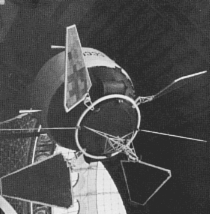Proton 1
Proton 1 was a Soviet satellite, launched in July 1965, that studied cosmic rays in the Gamma ray spectrum. It was the payload of the first Proton rocket launch. It was powered by 4 triangular solar panels mounted on the top of the spacecraft. The spacecraft itself was a cylindrical body with sloping cones to cap the ends. The satellites orbit decayed naturally and re-entered in October 1965.[1]
 Proton 1 before launch | |
| Mission type | Gamma-ray astronomy |
|---|---|
| COSPAR ID | 1965-054A |
| SATCAT no. | 01466 |
| Mission duration | 3 months, 25 days |
| Spacecraft properties | |
| Launch mass | 12,200 kg (26,900 lb) |
| Start of mission | |
| Launch date | July 16, 1965, 11:17 UTC |
| Rocket | Proton |
| Launch site | Baikonur Cosmodrome |
| End of mission | |
| Disposal | De-orbited |
| Decay date | October 11, 1965 |
| Orbital parameters | |
| Reference system | Geocentric |
| Regime | Low Earth orbit |
| Eccentricity | 0.029999 |
| Perigee altitude | 183 kilometers (114 mi) |
| Apogee altitude | 589 kilometers (366 mi) |
| Inclination | 63.4 degrees |
| Period | 92.25 minutes |
Scientific Payload
The scientific payload included instruments for monitoring cosmic rays with energies in the Gamma Ray spectrum. It measured particles above 50 MeV.
gollark: Amazon don't make HDDs.
gollark: The one in my server has *years* of power on time.
gollark: NAS/server ones are designed to never spin down because it takes a while to spin up.
gollark: What? Why?
gollark: Yes, flash things can only do 10000 writes or something. Less on newer denser ones.
See also
- Proton 2
This article is issued from Wikipedia. The text is licensed under Creative Commons - Attribution - Sharealike. Additional terms may apply for the media files.